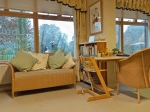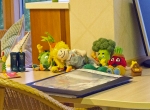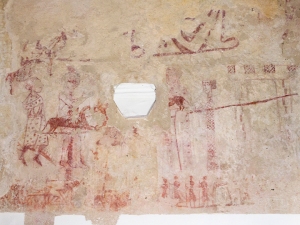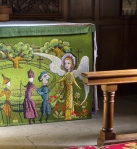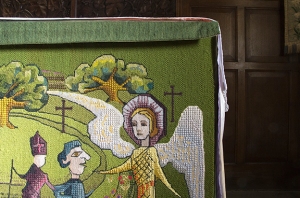People & Place Part Three : Buildings and spaces
Assignment 3 : Buildings in use
A: Preamble
People & Place has been a very challenging module for me and there have frequently been times when I’ve wished I’d chosen something different. This assignment has proved the most difficult so far. I have photographed buildings from both outside and inside but only occasionally. So, just as I had to leap over the stream to do portraits, I’ve now had to negotiate those slippery, algae covered, stepping stones over the river to get to the buildings on the other side. There have been times when I’ve nearly fallen off which is why this assignment has taken me so long to do.
Since my last Assignment, submitted in September, and in the midst of, again, having my artistic boundaries challenged, I’ve also been on three OCA Study Visits; participated in the OCA Brighton Weekend, been on an informal group visit to Somerset House and on my own to see the Nadav Kander Exhibition. So far, I’ve only written-up one of these (Prix Pictet ) for my blog. The main reason for the tardiness here is that I tend to get interested in particular photographers whose work I’ve viewed and then research them further. I’m hoping to catch up as quickly as possible though once Assignment 3 is complete. I’ve also started up a Personal Projects category on my blog. So far I’ve written up my interests in People and Traces, Infrared work; and Pylons. Additionally I’ve got into the habit of writing to photographers and asking if I may download images from their websites for my blog. Most of them have responded very positively which I’ve much appreciated.
B: Preparation for the Assignment
The Projects/Exercises asked us to show how buildings and other man-made spaces are used and how people interact with them – how these spaces work for the people who use them (function) and how spaces change with light. I’ve written this up, together with advice accessed on photographing interiors and how some other photographers have viewed interiors here. The Projects/Exercises seemed short but I took a long time in thinking around them. The major experience for me here concerned the phenomenology of architecture and spaces – how we human beings think and feel about spaces we inhabit and form attachments to them. Second to that was how can I show some of this personal connection in my own images.
C: The Assignment itself
- Choose 5 or 6 buildings and for each produce between two and four images that describe effectively and attractively the way in which these spaces are used.
- Conduct some research beforehand so as to have a good understanding of how and why it was designed in the way it is and an opinion on its effectiveness as a usable space
- Write a short statement demonstrating understanding of the function of each building, the way it was designed to achieve that, and how well you believe it succeeds.
- In addition, describe briefly how you initially set about showing the important features of each building photographically, and what you learned during the course of shooting the assignment.
From the start I wanted to have some kind of theme to link the buildings together, particularly as it is suggested that we choose a variety of buildings in terms of size, shape and use. Apart from the Muslim Burial Ground in Woking there is another place I feel especially drawn to which is St. Nicholas Church in Pyrford, situated in an area which is rich in history. When I was working I often drove down the hill past the Church, along a narrow lane which took me past Pyrford Golf Club before going over the bridge on the Wey Navigation Canal From there I travelled through Wisley and thence past the RHS Gardens, Wisley to reach the A3. I decided that I would use this route for the Assignment and visit all these places.
I also wanted to include a business complex in Wisley that is based in converted farm buildings next to the Church there. I wanted to see how use was made of the open- space offices. I couldn’t just walk in there due to electronic security gates so I emailed and then phoned the manager of one of the companies. He seemed willing at first but expressed concern about potential disruption with equipment etc. He said he would speak to one of his higher managers and get back to me. In the meantime, I emailed him again to reassure him that I would only be there for a short time (the length to be of his choosing) and would be using minimal equipment. I also provided copies of my student card and a letter from OCA confirming that I am a student, plus a link to the OCA website. Unfortunately he did not get back to me and so I decided to leave it at that as I didn’t want to be seen to be harassing him..
The area lies within the Parish of Wisley-with-Pyrford. Both villages were Saxon manors (which mostly remained under different ownership) although the parishes were united in 1631. Wisley Church and St Nicholas at Pyrford are on the line of a mediaeval track, the remains of which can be seen in the pathway at the west of St Nicholas’ church. The two churches have preserved three of their twelve consecration crosses as well as fragments of the Norman paintings which once covered their walls. (Lewin, S. p. 4). These two churches, together with the church of St Mary at Farleigh near Croydon are the three in the county of Surrey that have survived from Norman times as complete buildings of one period.
The Wisley estate (of which only a small part was cultivated as a garden) was presented to the Royal Horticultural Society (RHS) in 1903, in trust for its perpetual use, by Sir Thomas Hanbury, a wealthy Quaker.
The buildings
I’ll give further relevant information as I describe each building and am including an exterior shot for each to show the context – but these will not be submitted as assignment images.. In terms of cameras I used a DSLR (Canon 60D), Fuji EX-1 CSC with zoom lens and a Canon G12. I used a tripod where possible/appropriate. I always shoot in RAW. I decided to use auto White Balance to allow for mixed lighting on the basis that I could correct in processing. I’d previously found that auto white balance seemed much more sensitive to light and producing more variation than just using camera pre-sets.
In processing I made initial selections (RAW) with 1*, second selection (converted to Jpeg) by 2* and used a red label to select the final versions I also used a yellow label to select the external view I wanted to use for context. My tutor will be provided with digital versions of all images worked with; initial; second, and final selections, plus printed contacts sheets of second selections, from which I chose the final 19 images.
1: The Glasshouse , RHS Wisley
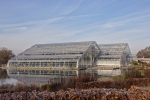
The structure was designed by the architect Peter van de Toorn Vrijthoff (Colborn & Terry, 2007) in conjunction with landscape designer Tom Stuart-Smith. It had to be designed to provide maximum light through the glazing whilst being strong enough to withstand severe weather. The glasshouse needs to keep plants warm on cold winter nights but not overheat during summer – and needs to be warmed or cooled with minimal use of energy. It has fuggers in the roof to maintain correct humidity and retractable sunblinds which double as heat-conserving thermal screens, with sources of artificial light to assist winter growth. It was designed to provide as authentic an experience as possible in each of its 3 interlinked climatic zones – dry temperate and moist temperate (adjacent in the main area) and a tropical zone overlooking the lake at the front. The lake itself acts as a reservoir in case of drought.
There are no barriers or doors to pass through and pathways and naturalistic landscaping enhance the atmosphere by showing distinct transitions between the zones. There is one main pathway in a figure of eight that leads you around the structure as you follow the contours of rocky outcrops and gently sloping gradients, with raised viewing platforms. A focal point inside is the temperate waterfall, in fact without it one would be able to view the entire floor area. The Glasshouse also has an interactive root-zone. Another area leads to a walkway to the linked teaching area.
I’ve been there several times before. It’s a good feeling to enter such a different space – wide, airy and full of greenness and the scent of flowers. It’s peaceful, never seems crowded. They have butterflies in the tropical zone for several weeks starting in January – weather hasn’t allowed a visit yet this year. They’re not easy to photograph though. It depends on how much moisture is in the air at any particular time. I think the whole design works excellently. It wasn’t until I went in there, looking with different eyes, that I appreciated how it has all been put together. The structure and design are all focused to enable the visitor to experience the ‘outside’ inside. It’s accessible to all ages and wheelchair friendly.
When photographing I had to allow for the dynamic range between the brightness of the light coming through the roof and the dark greenness inside. I visited twice. The first time the sky was almost white and so I went again the moment I saw a blue sky.
I wanted to find a way to show the height of the space and the way in which the different areas had been created. For this I went on the walkway which leads over the top of the waterfall. As I walked back down the slope I shot through the waterfall. The sight of people beyond the water always pleases me and I’ve noticed that many other people spend time there. Other shots were at ground level. When I went into the rootzone I had my tripod at a very low height so that I could gain a childs-eye viewpoint. I went into the tropical zone but my lens immediately misted over. One thing I noticed though was that the lift is camouflaged so that it fits in with the plants and I did take a quick couple of shots.
Images 1-4
I chose an initial selection of 36 and a second selection of 17, from which I chose 4 plus one of the exterior for context. My intention was to show the height of the structure; how the waterfall feature intersects the space and creates a topography.
As I worked through my choices and printed them I started to think I’d made the wrong choices because really, I think. People visit the Glasshouse for that overwhelming sense of warm greeness. I want to show, though, that there are other areas of interest.
2: Lindley Library, RHS,Wisley
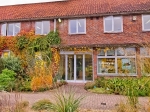
I hadn’t been able to find information about the architect of the Glasshouse so went into the library which is situated so that you walk past it on your way to the exit.
Anyone can access the library and look for information there and, if you are an RHS member you can also borrow books. The librarian was very helpful and found the book referenced below. It isn’t a large library but is very comfortable with almost a country house feel. Curtained windows overlook the Garden and botanical paintings are on the walls. There are laptop outlets (with PCs available) The book shelves are along one wall whilst the study areas are on the garden wall, with table lamps; Lloyd loom type cushioned- chairs and laptop outlets, plus some PCs available. One of the tables has a selection of children’s toys, books and drawing materials to keep children happy whilst parents do their research and reading. It’s obvious that considerable thought has been given to providing a comfortable and relatively studious atmosphere yet with some diversion for young children.
I didn’t think it would be appropriate to take out my large camera and so I used my Canon G12 after asking permission to take some photographs. The major problem was the mix of lighting – daylight from the windows, plus fluorescent ceiling lights and the tungsten table lamps.3
I chose 16 images and then 13 as converted jpeg, from which I chose 2 plus one of the exterior for context .
Images 5-7
Images 5 and 6 don’t capture the colours entirely correctly and adjusting white balance was difficult. I think auto to begin with was the best choice in view of the mixed lighting. I adjusted warmth and colour in PS also using Nik Viveza for some finer adjustments and added more saturation to the toys in No. 7 because bright colours are more attractive to children.
5: Wisley Church
This is a very small church but, even so, I’m surprised that there is one at all in Wisley as the place seems very much a road on the way from one place to another. It doesn’t have a village hall or shop and the nearest pub, the Anchor, is just outside Wisley. The information I have states that the village never consisted of more than a few farms and cottages (it’s hardly larger now) but its church was more important than its sister church in Pyrford. (Lewin & Blatch). Foundations of an earlier Saxon chapel (mentioned in the Domesday Book) were uncovered under the present building in 1903, but it is basically Norman work of the mid-12th century.
The stone on the exterior is undressed, apart from the rough flint C19th century vestry exterior and, because of this, of has had to be covered over with a rendering of sand mixed with lime. A hard form of chalkstone was used for the interior and small flints can still be seen embedded therein. There are many traces of original wall-paintings and three consecration crosses remain. The porch is C17th with a saw-toothed or notched bargeboard. A later brick base has been inserted but much of the timber framing appears to be original (Lewin & Blatch p.4).
I have visited this church once before. To me it seems a simple church without show or finery, more homely somehow than even its sister church St Nicholas in Pyrford. It has a peaceful air to me (as a non-believer) providing a space for quiet reflection and contemplation without distractions.
I visited the church twice for the purpose of the assignment – the second time when the day was brighter and the sky more blue. The major difficulty inside was due to the high dynamic range of the light. This is a low -built church and light falls through the windows into the darker interior in such a way that it can’t be avoided, even low-down.
From an initial choice of 40 I reduced this to 14 converted as jpeg and finally selected 4. plus two of the outside for context.
Images 8-11
4: Pyrford Golf Club
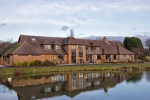
This club was established in 1993 so is relatively new. It was designed by former Ryder Cup Players Peter Alliss and Clive Clark and they were involved in the building of quite a few new clubs in Surrey around the same time. Plans first went before Woking Borough Council in October 1990. I remember there was continuing opposition from some of the nearby local residents who were concerned about the potential increase in traffic plus possible loss of freedom to walk on public footpaths.
Thinking about my ‘road trip’ I plucked up courage and phoned the current Manager, Nick Hughes, explaining I was a photography student, and asking if I could take some photographs. He said yes almost before I’d explained and was very welcoming, telling me to photograph whatever I liked and maybe let him have some of the good ones.
This is a modern clubhouse that, I think, is built to a general specification along the lines of the need for it to merge with a landscape and not be over-imposing in height (pre-existing pylons have been incorporated into the design). The landscaping of the course/s is very important because it has to provide challenge and variety. I’ve been told that this particular course is definitely a challenging one in the way it has been designed.
Thinking about the basic ‘function’ of a clubhouse, this would be to provide somewhere for members to change clothes; relax and socialize after a game and to have some refreshment. There also needs to be a shop to buy the various needed accessories and clothing. This is not a men only Club and so there needs to be separate changing facilities for women members. I haven’t been in that many golf clubs but I still have the impression of them being a place for men rather than women, with fairly dark walls and furniture. I was therefore particularly interested in how women were catered for. I spent some time in the ladies locker room; wandered in and out of the shop, and spent some time in the bar. The weather was very bad so there was hardly anyone playing golf outside but a few members were in the bar having breakfast and generally chatting. I had a nice conversation as well with the club captain who’d come over to ask what I was doing.
I think the Club does fulfil its function although it still has more of a masculine feel, despite the deep pink seating. This is probably due to the heaviness of the colours. The Ladies locker room has a softer feel with flowers and lighter wooden fitments.
From an initial selection of 40 I processed a further selection of 22 as jpegs and chose 4, plus 1 for exterior view.
Images 12-15
I used a remote speedlite flash for Image 13 that worked reasonably well against the rather dim overhead lighting. I’m not happy at all with 14 and 15. I toyed with the idea of not submitting them but decided against this. I need to learn from my mistakes and show my tutor how it affected the prints. Obviously the mixed lighting was a real issue again and with No. 15 there was the additional problem of light from the TV. Again – I adjusted individual colours.
5: St Nicholas Church, Pyrford
This Church is a Grade I listed building. I’ve read that it was completely re-built between 1140-60 under the auspices of Westminster Abbey so presumably it was built upon the foundations of an earlier Saxon church. The situation of the church, in a circular churchyard on the top of a hillock, indicates that it was a pagan holy place which was adapted by the early Christians. (Lewin, S, p.1).
Wall paintings
that were part of the original decorative scheme were whitewashed over by Protestant zealots in the reign of Edward VI (1547-53) but some remains of them were re-discovered during a sensitive restoration scheme in 1868-70. There are two sets, one painted over the other. The first series (dating from around 1140) shows scenes from Christ’s passion. The second series (from around 1220)) is known as a psychomachia, a battle between virtues and vices. The details are not very clear, but the painting is represented by the mysterious procession of armed men and a group of horsemen (A. Crosby, (2003) p.19) Crosby also quotes from the diaries of an Arthur Mumby of Wheelers Farm who described the work in progress, The interior was a heap of rubbish; all the old pews and seats gone or waiting rearrangement. A few scraps of old fresco, scraped bare, showed on the walls.” (ibid p. 20).
I’ve visited this Church many times over the past few years and have puzzled over its attraction for me. I think that a part of it is that I can sit there and feel surrounded by a great sense of history. There’s no pomp and splendour, glittering gold and noble tombs. This space and its surroundings have been considered ‘holy’ for centuries. What would people have felt/seen in pagan times? I put myself in the situation of someone sitting there in the 1200s during a service – the wall paintings might be viewed as a distraction but they were there to convey religious ‘messages’ to a mainly illiterate population.
Now, as I sit there, light pours through the low windows. I see flashes of colour from the bright hassocks. My eye catches the faint wall-paintings and is then drawn to the altar – its tapestry cover with Norman style figures. Everything delights my eyes and I feel at peace. This is what I’ve attempted to show in the images.
I chose an initial 20 images from which I selected 16 to convert to jpeg, and then a final 4, plus 2 for exterior context.
Images 16-19
Clipped highlights and whited windows really bothered me. Combining different exposure doesn’t seem to work with such a high dynamic range as in this church. I suppose if I could ask permission to go at night and then use my own lighting I might be able to resolve this for myself. Yet as I’ve researched on the internet and seen interior photographs they’re often there as well. Am I being too hard on myself?
Conclusions
Technical aspects
I have referred to these when discussing the individual buildings and have also provided my tutor with a chart of camera settings used in my final selection. I used a tripod wherever possible, apart from in the Library and Golf Club. It wasn’t always possible in the churches because of narrowness of pews etc where I wanted to get close to something but I rested my camera on top of pews or other available flat surfaces.
Using auto white-balance usually seems to work well but not with mixed lighting. In a perfect world I could switch off lights, mask windows etc but that wasn’t possible with this assignment. I have had to acknowledge that I need to get used to doing a custom white-balance in camera in such situations and not rely on post-processing. I also intend to get more to grips with adjustment layers in Photoshop and all the adjustments that Lightroom 4 offers.
Personal aspects
I started off not wanting to do this part of the course at all but gradually found myself drawn into the buildings; how their space is used and the atmosphere engendered. I’ve also been thinking about particular elements that made me choose these specific buildings – being able to enjoy ‘nature’ whilst being protected from the elements; feeling in tune with history and that sense of being in a timeline; early memories of being a child lost in books and stories and the wonders of the public library.
There are three books that have been shaping my thoughts around this and I intend to write more on this in another blog post. Briefly the books are Gaston Bachelard, The Poetics of Space. (1958); Simon Schama Landscape & Memory(1995) and Joel Smith The Life and death of Buildings: On Photography and Time (2011). Smith writes that “Buildings embody durational time” (p. 13) and that photographs are made of time, “Whatever a photograph represents, it represents in time; it represents a thing by representing a state of the thing” (p.14) they project the past. I was reminded of this looking at the drawings and photographs of St Nicholas Church taken at different time periods in Crosby’s book on the history of Woking.
Whilst Schama writes about the way in which landscapes embody culture and folk memories, Bachelard muses upon the way in which we bring our phenomenological experiences of our earliest homes and shelters into our dreams and memories and how, “…..the house we were born in is physically inscribed in us” (p. 14). I realise that this has implications in terms of how spaces are designed and created in buildings and how we interact with our present surroundings. Maybe an example of this is the way I react to St Nicholas’ Church. It has an almost maternal feel about the way it is designed with it curved roof and I have strong memories also of the dark wood and enclosing spaces in the house where I was born. Schama also writes of how the primitive grove of trees became translated into gothic churches. In the case of St Nicholas and Wisley churches we have the much earlier version where the trees have been brought into the church in the form of the roof timbers.
29th January 2013
References
Bachelard, G, (1958) The Poetics of Space, Beacon Press, Boston [1994 Ed.]
Colborn N & Perry, C (2007) A Garden under Class: The Glasshouse RHS London
Crosby, A (2003) A History of Woking Phillimore & Co. Ltd., Chichester, UK
Lewin,S & Blatch, M (1987) Wisley Chuch – Short History and Church Guide Printed pamphlet
Lewin, S (d unknown) A Short History of Pyrford and Wisley Printed pamphlet
Schama, S (1995) Landscape and Memory, HarperCollins Publishers, London
Smith, J (2011) The Life and Death of Buildings: On Photography and Time, Yale University Press
http://www.british-history.ac.uk/report.aspx?compid=42991
http://list.english-heritage.org.uk/resultsingle.aspx?uid=1044721
Church wall paintings
http://www.pyrford.com/history/pyrford.html
http://www.pyrfordgolf.co.uk/
http://www.rhs.org.uk/About-Us/RHS-Lindley-Library
http://www.rhs.org.uk/Gardens/Wisley/About-Wisley/History
http://www.rhs.org.uk/Gardens/Wisley/The-Glasshouse
Home



